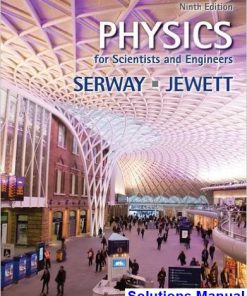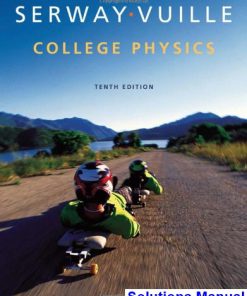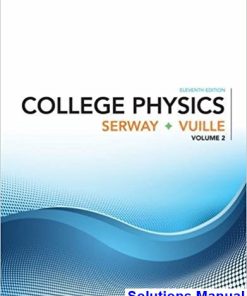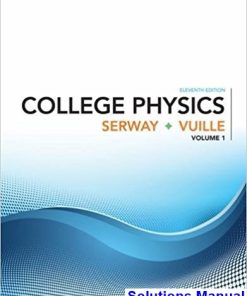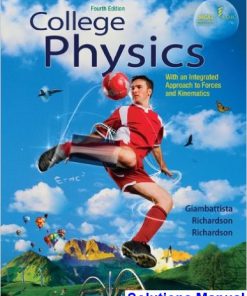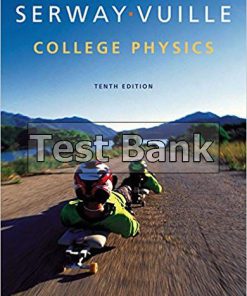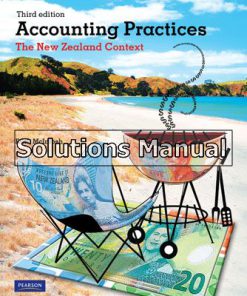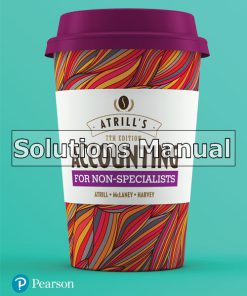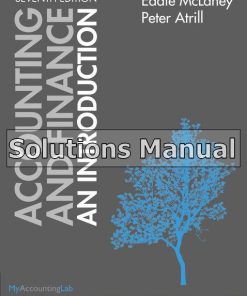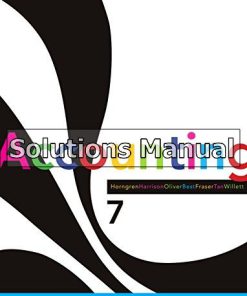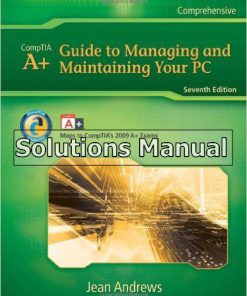College Physics 11th Edition Serway Solutions Manual
You may also like
-
$26.50
$50.00
This is completed downloadable of College Physics 11th Edition Serway Solutions Manual

Product Details:
- ISBN-10 : 9781305952300
- ISBN-13 : 978-1305952300
- Author: Raymond A. Serway, Chris Vuille
Succeed in your course, improve your problem-solving skills, and enrich your understanding of the world around you with COLLEGE PHYSICS, Eleventh Edition! This proven text combines a logical presentation of physical concepts with a consistent strategy for solving problems and an unparalleled array of worked examples to help you master the concepts and skills of the course.
Table of Content:
- Topic 1: Units, Trigonometry, and Vectors
- 1.1 Standards of Length, Mass, and Time
- 1.2 The Building Blocks of Matter
- 1.3 Dimensional Analysis
- 1.4 Uncertainty in Measurement and Significant Figures
- 1.5 Unit Conversions for Physical Quantities
- 1.6 Estimates and Order-of-Magnitude Calculations
- 1.7 Coordinate Systems
- 1.8 Trigonometry Review
- 1.9 Vectors
- 1.10 Components of a Vector
- 1.11 Problem-Solving Strategy
- Summary
- Topic 2: Motion in One Dimension
- 2.1 Displacement, Velocity, and Acceleration
- 2.2 Motion Diagrams
- 2.3 One-Dimensional Motion with Constant Acceleration
- 2.4 Freely Falling Objects
- Summary
- Topic 3: Motion in Two Dimensions
- 3.1 Displacement, Velocity, and Acceleration in Two Dimensions
- 3.2 Two-Dimensional Motion
- 3.3 Relative Velocity
- Summary
- Topic 4: Newton’s Laws of Motion
- 4.1 Forces
- 4.2 The Laws of Motion
- 4.3 The Normal and Kinetic Friction Forces
- 4.4 Static Friction Forces
- 4.5 Tension Forces
- 4.6 Applications of Newton’s Laws
- 4.7 Two-Body Problems
- Summary
- Topic 5: Energy
- 5.1 Work
- 5.2 Kinetic Energy and the Work-Energy Theorem
- 5.3 Gravitational Potential Energy
- 5.4 Gravity and Nonconservative Forces
- 5.5 Spring Potential Energy
- 5.6 Systems and Energy Conservation
- 5.7 Power
- 5.8 Work Done by a Varying Force
- Summary
- Topic 6: Momentum, Impulse, and Collisions
- 6.1 Momentum and Impulse
- 6.2 Conservation of Momentum
- 6.3 Collisions in One Dimension
- 6.4 Glancing Collisions
- 6.5 Rocket Propulsion
- Summary
- Topic 7: Rotational Motion and Gravitation
- 7.1 Angular Velocity and Angular Acceleration
- 7.2 Rotational Motion Under Constant Angular Acceleration
- 7.3 Tangential Velocity, Tangential Acceleration, and Centripetal Acceleration
- 7.4 Newton’s Second Law for Uniform Circular Motion
- 7.5 Newtonian Gravitation
- Summary
- Topic 8: Rotational Equilibrium and Dynamics
- 8.1 Torque
- 8.2 Center of Mass and Its Motion
- 8.3 Torque and the Two Conditions for Equilibrium
- 8.4 The Rotational Second Law of Motion
- 8.5 Rotational Kinetic Energy
- 8.6 Angular Momentum
- Summary
- Topic 9: Fluids and Solids
- 9.1 States of Matter
- 9.2 Density and Pressure
- 9.3 Variation of Pressure with Depth
- 9.4 Pressure Measurements
- 9.5 Buoyant Forces and Archimedes’ Principle
- 9.6 Fluids in Motion
- 9.7 Other Applications of Fluid Dynamics
- 9.8 Surface Tension, Capillary Action, and Viscous Fluid Flow
- 9.9 Transport Phenomena
- 9.10 The Deformation of Solids
- Summary
- Topic 10: Thermal Physics
- 10.1 Temperature and the Zeroth Law of Thermodynamics
- 10.2 Thermometers and Temperature Scales
- 10.3 Thermal Expansion of Solids and Liquids
- 10.4 The Ideal Gas Law
- 10.5 The Kinetic Theory of Gases
- Summary
- Topic 11: Energy in Thermal Processes
- 11.1 Heat and Internal Energy
- 11.2 Specific Heat
- 11.3 Calorimetry
- 11.4 Latent Heat and Phase Change
- 11.5 Energy Transfer
- 11.6 Climate Change and Greenhouse Gases
- Summary
- Topic 12: The Laws of Thermodynamics
- 12.1 Work in Thermodynamic Processes
- 12.2 T he First Law of Thermodynamics
- 12.3 Thermal Processes in Gases
- 12.4 Heat Engines and the Second Law of Thermodynamics
- 12.5 Entropy
- 12.6 Human Metabolism
- Summary
- Topic 13: Vibrations and Waves
- 13.1 Hooke’s Law
- 13.2 Elastic Potential Energy
- 13.3 Concepts of Oscillation Rates in Simple Harmonic Motion
- 13.4 Position, Velocity, and Acceleration as Functions of Time
- 13.5 Motion of a Pendulum
- 13.6 Damped Oscillations
- 13.7 Waves
- 13.8 Frequency, Amplitude, and Wavelength
- 13.9 The Speed of Waves on Strings
- 13.10 Interference of Waves
- 13.11 Reflection of Waves
- Summary
- Topic 14: Sound
- 14.1 Producing a Sound Wave
- 14.2 Characteristics of Sound Waves
- 14.3 T he Speed of Sound
- 14.4 Energy and Intensity of Sound Waves
- 14.5 Spherical and Plane Waves
- 14.6 The Doppler Effect
- 14.7 Interference of Sound Waves
- 14.8 Standing Waves
- 14.9 Forced Vibrations and Resonance
- 14.10 Standing Waves in Air Columns
- 14.11 Beats
- 14.12 Quality of Sound
- 14.13 The Ear
- Summary
- Topic 15: Electric Forces and Fields
- 15.1 Electric Charges, Insulators, and Conductors
- 15.2 Coulomb’s Law
- 15.3 Electric Fields
- 15.4 Electric Field Lines
- 15.5 Conductors in Electrostatic Equilibrium
- 15.6 The Millikan Oil-Drop Experiment
- 15.7 The Van de Graaff Generator
- 15.8 Electric Flux and Gauss’ Law
- Summary
- Topic 16: Electrical Energy and Capacitance
- 16.1 Electric Potential Energy and Electric Potential
- 16.2 Electric Potential and Potential Energy of Point Charges
- 16.3 Potentials, Charged Conductors, and Equipotential Surfaces
- 16.4 Applications
- 16.5 Capacitors
- 16.6 Combinations of Capacitors
- 16.7 Energy in a Capacitor
- 16.8 Capacitors with Dielectrics
- Summary
- Topic 17: Current and Resistance
- 17.1 Electric Current
- 17.2 A Microscopic View: Current and Drift Speed
- 17.3 Current and Voltage Measurements In Circuits
- 17.4 Resistance, Resistivity, and Ohm’s Law
- 17.5 Temperature Variation of Resistance
- 17.6 Electrical Energy and Power
- 17.7 Superconductors
- 17.8 Electrical Activity in the Heart
- Summary
- Topic 18: Direct-Current Circuits
- 18.1 Sources of EMF
- 18.2 Resistors in Series
- 18.3 Resistors in Parallel
- 18.4 Kirchhoff’s Rules and Complex DC Circuits
- 18.5 RC Circuits
- 18.6 Household Circuits
- 18.7 Electrical Safety
- 18.8 Conduction of Electrical Signals by Neurons
- Summary
- Topic 19: Magnetism
- 19.1 Magnets
- 19.2 Earth’s Magnetic Field
- 19.3 Magnetic Fields
- 19.4 Motion of a Charged Particle in a Magnetic Field
- 19.5 Magnetic Force on a Current-Carrying Conductor
- 19.6 Magnetic Torque
- 19.7 Ampere’s Law
- 19.8 Magnetic Force Between Two Parallel Conductors
- 19.9 Magnetic Fields of Current Loops and Solenoids
- 19.10 Magnetic Domains
- Summary
- Topic 20: Induced Voltages and Inductance
- 20.1 Induced EMF and Magnetic Flux
- 20.2 Faraday’s Law of Induction and Lenz’s Law
- 20.3 Motional EMF
- 20.4 Generators
- 20.5 Self-Inductance
- 20.6 RL Circuits
- 20.7 Energy Stored in Magnetic Fields
- Summary
- Topic 21: Alternating-Current Circuits and Electromagnetic Waves
- 21.1 Resistors in an AC Circuit
- 21.2 Capacitors in an AC Circuit
- 21.3 Inductors in an AC Circuit
- 21.4 The RLC Series Circuit
- 21.5 Power in an AC Circuit
- 21.6 Resonance in a Series RLC Circuit
- 21.7 The Transformer
- 21.8 Maxwell’s Predictions
- 21.9 Hertz’s Confirmation of Maxwell’s Predictions
- 21.10 Production of Electromagnetic Waves by an Antenna
- 21.11 Properties of Electromagnetic Waves
- 21.12 T he Spectrum of Electromagnetic Waves
- 21.13 The Doppler Effect for Electromagnetic Waves
- Summary
- Topic 22: Reflection and Refraction of Light
- 22.1 The Nature of Light
- 22.2 Reflection and Refraction
- 22.3 The Law of Refraction
- 22.4 Dispersion and Prisms
- 22.5 The Rainbow
- 22.6 Huygens’ Principle
- 22.7 Total Internal Reflection
- Summary
- Topic 23: Mirrors and Lenses
- 23.1 Flat Mirrors
- 23.2 Images Formed by Spherical Mirrors
- 23.3 Images Formed by Refraction
- 23.4 Atmospheric Refraction
- 23.5 Thin Lenses
- 23.6 Lens and Mirror Aberrations
- Summary
- Topic 24: Wave Optics
- 24.1 Conditions for Interference
- 24.2 Young’s Double-Slit Experiment
- 24.3 Change of Phase Due to Reflection
- 24.4 Interference in Thin Films
- 24.5 Using Interference to Read CDs and DVDs
- 24.6 Diffraction
- 24.7 Single-Slit Diffraction
- 24.8 Diffraction Gratings
- 24.9 Polarization of Light Waves
- Summary
- Topic 25: Optical Instruments
- 25.1 The Camera
- 25.2 The Eye
- 25.3 The Simple Magnifier
- 25.4 The Compound Microscope
- 25.5 The Telescope
- 25.6 Resolution of Single-Slit and Circular Apertures
- 25.7 The Michelson Interferometer
- Summary
- Topic 26: Relativity
- 26.1 Galilean Relativity
- 26.2 The Speed of Light
- 26.3 Einstein’s Principle of Relativity
- 26.4 Consequences of Special Relativity
- 26.5 Relativistic Momentum
- 26.6 Relative Velocity in Special Relativity
- 26.7 Relativistic Energy and the Equivalence of Mass and Energy
- 26.8 General Relativity
- Summary
- Topic 27: Quantum Physics
- 27.1 Blackbody Radiation and Planck’s Hypothesis
- 27.2 The Photoelectric Effect and the Particle Theory of Light
- 27.3 X – Rays
- 27.4 Diffraction of X-Rays by Crystals
- 27.5 The Compton Effect
- 27.6 The Dual Nature of Light and Matter
- 27.7 The Wave Function
- 27.8 The Uncertainty Principle
- Summary
- Topic 28: Atomic Physics
- 28.1 Early Models of the Atom
- 28.2 Atomic Spectra
- 28.3 The Bohr Model
- 28.4 Quantum Mechanics and the Hydrogen Atom
- 28.5 The Exclusion Principle and the Periodic Table
- 28.6 Characteristic X-Rays
- 28.7 Atomic Transitions and Lasers
- Summary
- Topic 29: Nuclear Physics
- 29.1 Some Properties of Nuclei
- 29.2 Binding Energy
- 29.3 Radioactivity
- 29.4 The Decay Processes
- 29.5 Natural Radioactivity
- 29.6 Nuclear Reactions
- 29.7 Medical Applications of Radiation
- Summary
- Topic 30: Nuclear Energy and Elementary Particles
- 30.1 Nuclear Fission
- 30.2 Nuclear Fusion
- 30.3 Elementary Particles and the Fundamental Forces
- 30.4 Positrons and Other Antiparticles
- 30.5 Classification of Particles
- 30.6 Conservation Laws
- 30.8 Quarks and Color
- 30.9 Electroweak Theory and the Standard Model
- 30.10 The Cosmic Connection
- 30.11 Unanswered Questions in Cosmology
- 30.12 Problems and Perspectives
- Summary
- Appendix A: Mathematics Review
- Appendix B: An Abbreviated Table of Isotopes
- Appendix C: Some Useful Tables
- Appendix D: SI Units
- Answers: Quick Quizzes, Example Questions, and Odd-Numbered Conceptual Questions and Problems
- Index
People Also Search:
college physics serway
college physics 11th edition serway
college physics
college physics 11th edition
college physics 11th edition download scribd
college physics 11th edition solution manual download pdf

